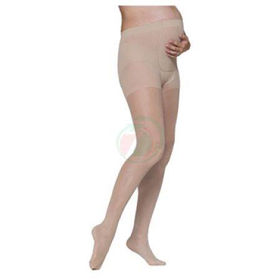Customer question:
Can compression stockings also be bought in a pharmacy? Anonymous customer's question
Pharmacist's answer:
Yes, compression stockings can also be bought in pharmacies. They come in various lengths, including knee-high, thigh-high, and full-length tights. In our online pharmacy, you can view the range of compression stockings at the link below:
https://www.moja-lekarna.com/kompresijse-nogavice
How do you choose suitable compression stockings?
Choosing the right compression socks involves considering several factors, including why you need them, the required compression level, fit, and material. Conditions such as deep vein thrombosis (DVT), varicose veins, edema, or lymphedema require exceptional compression levels. If you use them due to a medical condition, you should consult your doctor.
Some athletes use compression socks to improve performance or aid recovery after exercise. People who stand or sit for long periods, such as nurses or office workers, can use compression stockings to reduce leg fatigue and swelling.
Choose the right compression level:
- Mild compression (8-15 mmHg): for daily wear, minor leg swelling, tired legs, or to prevent DVT.
- Moderate compression (15-20 mmHg): suitable for treating varicose veins, reducing swelling, or preventing deep vein thrombosis during long trips.
- Firm compression (20-30 mmHg): prescribed for moderate to severe edema, lymphedema, after vein surgery, or for treating active varicose veins.
- Extra firm compression (30-40 mmHg) and higher: suitable for severe health problems and always requires a doctor's prescription.
Socks come in various materials, including cotton, microfiber, nylon, and lycra. Your choice will depend on your preferences for comfort, desired durability, and any allergies or skin sensitivities. Based on your needs and your doctor's recommendations, determine how long you should wear them each day. Some people can only wear them during working hours, while others wear them almost continuously.
Do compression stockings help with edema?
Compression stockings are commonly used to help manage edema, especially in the legs. Compression socks gradually apply pressure to the leg, meaning that the compression is highest at the ankle and gradually decreases as it goes up the leg. This gradual pressure encourages venous blood flow back toward the heart and helps prevent fluid accumulation in the tissues, thus reducing swelling.
Regular use can help reduce fluid build-up in the legs, alleviating edema-related discomfort. Chronic edema can cause skin changes, including thickening, discoloration, and ulceration. Compression stockings can help prevent or mitigate these changes. They can also help promote venous blood return, reducing the risk of blood clots.
You must choose the appropriate level of compression and ensure a proper fit. The correct compression level usually depends on the severity of the edema and the underlying cause. How long and often compression stockings should be worn depends on the cause and severity of the edema and personal comfort. Some individuals may need to wear them throughout the day, while others may only need them for certain activities.
While compression stockings can be very helpful in managing edema, it is also essential to address the underlying cause of the swelling. This may include medications, other medical procedures, leg elevation, and special exercises. Improper use, such as wearing too tight or inappropriate socks for your condition, can cause health problems. Monitoring for reduced circulation, skin irritation, or other complications is essential.
What is the price of compression stockings?
The price of compression stockings depends on several factors. Over-the-counter compression stockings with mild compression levels are often less expensive than prescription or custom-made stockings. Knee socks are generally cheaper than thigh socks or pantyhose.
Premium or well-known brands may be priced higher than generic or lesser-known brands. Also, socks with higher-quality materials or advanced features may be more expensive. Some socks have additional features such as antimicrobial properties, the ability to wick away moisture, or unique design elements to make them easier to put on. You can incline depending on the price.
Can compression stockings be used preventively?
Yes, compression stockings can be used preventively for several reasons:
- Travel: Long periods of inactivity during air travel can increase the risk of deep vein thrombosis (DVT). Compression stockings can help improve blood circulation in the legs and reduce the risk of DVT during long years.
- Occupation: People who stand or sit for long periods, such as nurses, flight attendants, or office workers, can use compression stockings to prevent leg fatigue, swelling, and varicose veins.
- Sports performance and recovery: some athletes wear compression stockings to improve performance during exercise or aid recovery after exercise by promoting better blood flow and reducing muscle soreness.
- Pregnancy: Pregnant women may develop varicose veins or leg swelling due to increased blood volume and hormonal changes. Compression stockings can be used to prevent or manage these problems during pregnancy.
- Prevention of varicose veins: People at risk of developing varicose veins due to hereditary factors or occupational risks can use compression stockings as a preventive measure.
- After surgery: After certain types of surgery, especially those involving the legs or abdomen, compression stockings may prevent blood clots from forming.
- Orthostatic hypotension: Individuals who experience a significant drop in blood pressure upon standing may use compression stockings to prevent symptoms associated with orthostatic hypotension.
In the preventive use of compression stockings, it is usually recommended to use those with a milder level of compression, such as 8-15 mmHg or 15-20 mmHg, unless otherwise directed by a doctor or pharmacist.
Interesting reading: Ointment for barley on the eye pharmacy












 Facebook
Facebook
 Instagram
Instagram
 info@moja-lekarna.com
info@moja-lekarna.com

